Consideration of Grappling & Wrestling in Renaissance Fencing
Part 2
By John Clements, ARMA Director
 In
the 1470’s Paris de Puteo had noted that in a formal duel if
a sword was broken he might properly fighting by twisting his opponent’s
arm, biting him, etc. But by 1553, Venetian, Antonio Possevino stated
that to purposely discard a serviceable weapon in favor of fist fighting
or to engage in wrestling, kicking, etc. was dishonorable because the
contest should be a test of strength not of the body. Such actions were
deemed appropriate for dueling gentry if conducted within the course
of an armed struggle --that is, they were allowable while still armed.
From the early 1500’s there is the account of a formal duel sanctioned
by the Grand Duke Alphonso in Ferrara, Italy where the challenged party
(in an obvious attempt to prevent such actions) attempted to wear armor
with sharp projections at places where an adversary would typically try
to take hold. Objecting, the Duke summoned forth a smith to file down
the offending sharp points on grounds that such was not the proper manner
of armor worn by knights in war. In
the 1470’s Paris de Puteo had noted that in a formal duel if
a sword was broken he might properly fighting by twisting his opponent’s
arm, biting him, etc. But by 1553, Venetian, Antonio Possevino stated
that to purposely discard a serviceable weapon in favor of fist fighting
or to engage in wrestling, kicking, etc. was dishonorable because the
contest should be a test of strength not of the body. Such actions were
deemed appropriate for dueling gentry if conducted within the course
of an armed struggle --that is, they were allowable while still armed.
From the early 1500’s there is the account of a formal duel sanctioned
by the Grand Duke Alphonso in Ferrara, Italy where the challenged party
(in an obvious attempt to prevent such actions) attempted to wear armor
with sharp projections at places where an adversary would typically try
to take hold. Objecting, the Duke summoned forth a smith to file down
the offending sharp points on grounds that such was not the proper manner
of armor worn by knights in war.
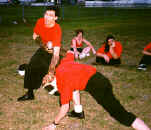 One late 1500s duel between a Signor Amadeo and one Crequi was fought
on an island in the Rhone. Crequi brought Amadeo to the ground and without
more ado killed him there (Amadeo’s relatives later complained
of the undignified recumbent manner in which their fellow perished).
Giraldi Cinzio describes a duel of c. 1564 in which an old fencing master
named Pirro at Beneveto fought with Sergesto, a young former student.
Pirro struck him on the back of the knee with the flat of his blade,
pushed him to the ground, disarmed him and, seizing his throat, made
him surrender. One late 1500s duel between a Signor Amadeo and one Crequi was fought
on an island in the Rhone. Crequi brought Amadeo to the ground and without
more ado killed him there (Amadeo’s relatives later complained
of the undignified recumbent manner in which their fellow perished).
Giraldi Cinzio describes a duel of c. 1564 in which an old fencing master
named Pirro at Beneveto fought with Sergesto, a young former student.
Pirro struck him on the back of the knee with the flat of his blade,
pushed him to the ground, disarmed him and, seizing his throat, made
him surrender.
The master Salvatore Fabris in 1606 depicted a range of close-in and
second-hand actions even showing a closing to take down the opponent
by grabbing him around the waist. Yet Fabris only included material on
grips and seizing reluctantly, because his text was focused on defense
with the sword in a way so effective that gentlemen would "never
need to come to grips on the seizing of swords". As with other masters,
his method was essentially aimed at encounters of honor within the code
duello. Apparently though, whatever his opinion of them as appropriate
for his readers he did understand and teach these other skills in some
way to prepare his students for them. Fabris’ close-in moves were
influential enough for several later rapier masters, including Heussler
in 1615, L’Lange in 1664, and Porath as late as 1693, to all copy
them (Siegmund Weischner in his small-sword treatise, Die Ritterliche
Geschicklichkeit im Fechten, of 1765 also shows a variety of closing
actions and grapples similar to Fabris).
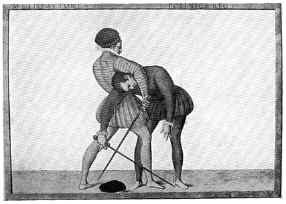 Given the range of techniques and actions is in the historical accounts,
a pattern is discernable. In a 1613 rapier duel between Sir John Heidon,
the Earl of Dorset, and Lord Bruce, Heidon not only put his opponent
on the ground, but jumped him afterward. Heidon wrote: "And there
we wrestled for the two greatest and dearest prizes we could ever expect
trial for –life and honor. Myself being wounded…I struck…passed
through his body, and drawing back my sword, repassed through again…I
easily became master of him, laying him on his back, when, being upon
him …I could not find in my heart to offer him any more violence,
only keeping him down". In a single combat during the English Civil
Wars, Scotsman Sir Ewen Lochiel, chief of the clan Cameron fought a valiant
English officer after several moments and exchange of blows, Lochiel
finally disarmed his antagonist and they wrestled until they fell to
the ground grappling. The Englishman gained the advantage but Lochiel
managed to get his hands free, grabbed his foes collar and: "fastening
his teeth upon his throat, brought away a mouthful of flesh, which, he
said, was ‘the sweetest bit he ever had in his life.’" Given the range of techniques and actions is in the historical accounts,
a pattern is discernable. In a 1613 rapier duel between Sir John Heidon,
the Earl of Dorset, and Lord Bruce, Heidon not only put his opponent
on the ground, but jumped him afterward. Heidon wrote: "And there
we wrestled for the two greatest and dearest prizes we could ever expect
trial for –life and honor. Myself being wounded…I struck…passed
through his body, and drawing back my sword, repassed through again…I
easily became master of him, laying him on his back, when, being upon
him …I could not find in my heart to offer him any more violence,
only keeping him down". In a single combat during the English Civil
Wars, Scotsman Sir Ewen Lochiel, chief of the clan Cameron fought a valiant
English officer after several moments and exchange of blows, Lochiel
finally disarmed his antagonist and they wrestled until they fell to
the ground grappling. The Englishman gained the advantage but Lochiel
managed to get his hands free, grabbed his foes collar and: "fastening
his teeth upon his throat, brought away a mouthful of flesh, which, he
said, was ‘the sweetest bit he ever had in his life.’"
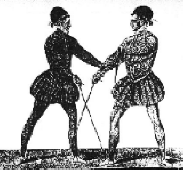 In his 1657 work on rapiers, weapons, and unarmed combat the German
master of arms, Johan Georg Pascha, reveals an extraordinary range of
unarmed techniques (which some have said resemble styles of Chinese wing
chung kung fu). It would not be difficult to believe that Pascha, who
was also a rapier master, would have utilized these in his fencing method.
We must consider that since he did not show them does not necessarily
serve as evidence he excluded them. A fighter always uses what he knows.
As Dr. Anglo relates, "For many centuries, the fighting taught by
professional masters was relevant either on the battlefield, in the formal
duel or in a brawl. The space given to the difficult skills required
in each case varied from author to author, place to place, and (certainly)
from time to time." Dr. Anglo points out that in the late 1600s,
the philosopher John Locke wrote that an unskilled fencer with skill
in wrestling has the "odds against a moderate fencer". Locke
believed for a man to prepare his son for duels, "I had much rather
mine should be a good wrestler than an ordinary fencer; which the most
any gentleman can attain to in it, unless he will be constantly in the
fencing school, and every day exercising." Scots master, Sir William
Hope in his 1707, "New Method" fencing book also speaks highly
of grips and tripping (although not as something to be casually practiced
in class). In 1720, Sir Thomas Parkyns in his Cornish-Hugg Wrestler explains, "I
illustrate how useful Wrestling is to a Gentleman in Fencing, in the
following Example of Parrying, and leave it to the ingenious, to make
a farther Application as oft as an Opportunity shall offer itself." In his 1657 work on rapiers, weapons, and unarmed combat the German
master of arms, Johan Georg Pascha, reveals an extraordinary range of
unarmed techniques (which some have said resemble styles of Chinese wing
chung kung fu). It would not be difficult to believe that Pascha, who
was also a rapier master, would have utilized these in his fencing method.
We must consider that since he did not show them does not necessarily
serve as evidence he excluded them. A fighter always uses what he knows.
As Dr. Anglo relates, "For many centuries, the fighting taught by
professional masters was relevant either on the battlefield, in the formal
duel or in a brawl. The space given to the difficult skills required
in each case varied from author to author, place to place, and (certainly)
from time to time." Dr. Anglo points out that in the late 1600s,
the philosopher John Locke wrote that an unskilled fencer with skill
in wrestling has the "odds against a moderate fencer". Locke
believed for a man to prepare his son for duels, "I had much rather
mine should be a good wrestler than an ordinary fencer; which the most
any gentleman can attain to in it, unless he will be constantly in the
fencing school, and every day exercising." Scots master, Sir William
Hope in his 1707, "New Method" fencing book also speaks highly
of grips and tripping (although not as something to be casually practiced
in class). In 1720, Sir Thomas Parkyns in his Cornish-Hugg Wrestler explains, "I
illustrate how useful Wrestling is to a Gentleman in Fencing, in the
following Example of Parrying, and leave it to the ingenious, to make
a farther Application as oft as an Opportunity shall offer itself."
Even into the 1700's there are notable accounts of grappling, wrestling
and all-out fighting occuring during upper-class duels between skilled
fencers. In a 1750 small-sword duel between two German noblemen, Swiegel
and Freychappel, the combat lasted nearly an hour during which both were
many times wounded. Eventually, Freychappel in trying to rush his opponent,
tripped and fell and was instantly run through and killed by Swiegel.
In his 1771 fencer’s guide for broadsword, A. Lonnergan at one
point instructs, "When I begin to advance the left hand to disarm
you, spring back, making a blow at it; or, if you think yourself as powerful
as your adversary, oppose force to force, then the weaker must go to
the ground, if some knowledge of wrestling does not prevent it." In
1772, a duel between Richard Sheridan and Captain Mathews, after missing
with pistols, they closed with small-swords, which were each broken on
the first lunge. "They then fought with the broken parts until each
received many wounds, Sheridan some very dangerous ones. They at last
fell to the ground and fought until separated by their seconds, Mr. Sheridan
being borne from the field with a portion of his antagonist's weapon
sticking through an ear, his breast-bone touched, his whole body covered
with wounds and blood, and his face nearly beaten to a jelly with the
hilt of Matthew's' sword."
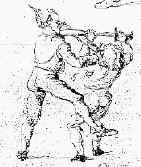 That some Renaissance masters and courtiers did frown on these close
fighting actions is true. The view that a lengthy agile sword should
alone be sufficient for defense is a reasonable one (and is highly reminiscent
today of the recent grappling/ground-fighting deficiency so effectively
argued against the more traditional "stand-up kick/punch" martial
artists). It is perfectly reasonable that two gentlemen would prefer
to have an "honorable" quarrel settled by "sword skill",
rather than risk "scuffling in the dirt" and getting bashed
in the face (of which there are several accounts). But just as with schools
of modern martial arts or knife-fighting or hand-gun training now, there
were theories of fighting back then that were more ideal than reality.
There were also styles that felt no cause to address certain possibilities
that would be more or less unlikely to be employed by the parties in
a formal aristocratic duel. That some Renaissance masters and courtiers did frown on these close
fighting actions is true. The view that a lengthy agile sword should
alone be sufficient for defense is a reasonable one (and is highly reminiscent
today of the recent grappling/ground-fighting deficiency so effectively
argued against the more traditional "stand-up kick/punch" martial
artists). It is perfectly reasonable that two gentlemen would prefer
to have an "honorable" quarrel settled by "sword skill",
rather than risk "scuffling in the dirt" and getting bashed
in the face (of which there are several accounts). But just as with schools
of modern martial arts or knife-fighting or hand-gun training now, there
were theories of fighting back then that were more ideal than reality.
There were also styles that felt no cause to address certain possibilities
that would be more or less unlikely to be employed by the parties in
a formal aristocratic duel.
 Yet, because a Renaissance master of arms produced one text on one aspect
of fighting (i.e., rapier dueling) for one particular audience, does
it necessarily mean that we can assume he was not at all adept at other
styles of sword or rapier fighting? When reconstructing aspects of Renaissance
fencing today, it is narrow and self-defeating to attempt to canonize
the minority of masters who either disapproved of or failed to address
close fighting from those who did. As Dr. Anglo has concluded, "Whatever
the theoretical status of wrestling among the learned and knightly classes,
it is obvious from surviving treatises that, up to the early seventeenth
century and even beyond, many master of arms recognized the advantage
bestowed upon their pupils by the physical exercise of wrestling – in
order to develop agility, strength, and dexterity – and by practicing
unarmed combat to use against the assaults of an armed assailant or in
any other mortal affray". Yet, because a Renaissance master of arms produced one text on one aspect
of fighting (i.e., rapier dueling) for one particular audience, does
it necessarily mean that we can assume he was not at all adept at other
styles of sword or rapier fighting? When reconstructing aspects of Renaissance
fencing today, it is narrow and self-defeating to attempt to canonize
the minority of masters who either disapproved of or failed to address
close fighting from those who did. As Dr. Anglo has concluded, "Whatever
the theoretical status of wrestling among the learned and knightly classes,
it is obvious from surviving treatises that, up to the early seventeenth
century and even beyond, many master of arms recognized the advantage
bestowed upon their pupils by the physical exercise of wrestling – in
order to develop agility, strength, and dexterity – and by practicing
unarmed combat to use against the assaults of an armed assailant or in
any other mortal affray".
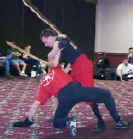 The abandonment by later generations (living under very different conditions)
of techniques which were a long-established part of the repertoire of
many masters does not negate either their significance or their martial
effectiveness (all Hollywood musketeer slapstick aside). Just because
later 18th and 19th century duelists decided certain moves were "dastardly" and "unsuited" to
their notions (artificial or not) of "fair" gentlemanly contests,
does not mean all men fighting for their very lives in the violent 1500s
and 1600s felt the same. As Dr. Anglo has keenly summarized, "There
were many different types of sword, and they were not all handled in
the same way. There were many different masters, and – however
much they traveled about to gain experience, copied each other, or developed
similar solutions to similar questions – they each had their own
ideas about how to do things…the history of fencing is a good deal
less straightforward than was at one time supposed". The abandonment by later generations (living under very different conditions)
of techniques which were a long-established part of the repertoire of
many masters does not negate either their significance or their martial
effectiveness (all Hollywood musketeer slapstick aside). Just because
later 18th and 19th century duelists decided certain moves were "dastardly" and "unsuited" to
their notions (artificial or not) of "fair" gentlemanly contests,
does not mean all men fighting for their very lives in the violent 1500s
and 1600s felt the same. As Dr. Anglo has keenly summarized, "There
were many different types of sword, and they were not all handled in
the same way. There were many different masters, and – however
much they traveled about to gain experience, copied each other, or developed
similar solutions to similar questions – they each had their own
ideas about how to do things…the history of fencing is a good deal
less straightforward than was at one time supposed".
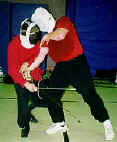 There is little question that a swordsman in the 1500s & 1600s had
to be fully skilled, not just for facing gentlemen il duello, but for
a fight a’ la machia or duel a’ la mazza (essentially a private
less formal quarrel out in the woods by either noble or commoner). He
also had to be ready to defend himself against any unexpected onslaught,
sudden ambush, or assault by strangers. He had to draw his weapon, size
up the situation, face multiple attackers and survive or safely flee.
In other words, he had to be able to fight those who weren’t "playing
by the rules". There are numerous accounts of gentlemen in hot temper
vengefully surprising their rivals. Affairs of honor wherein the adversary
stood firm politely announcing, "On guard, sir!" was the exception
not the rule. There is little question that a swordsman in the 1500s & 1600s had
to be fully skilled, not just for facing gentlemen il duello, but for
a fight a’ la machia or duel a’ la mazza (essentially a private
less formal quarrel out in the woods by either noble or commoner). He
also had to be ready to defend himself against any unexpected onslaught,
sudden ambush, or assault by strangers. He had to draw his weapon, size
up the situation, face multiple attackers and survive or safely flee.
In other words, he had to be able to fight those who weren’t "playing
by the rules". There are numerous accounts of gentlemen in hot temper
vengefully surprising their rivals. Affairs of honor wherein the adversary
stood firm politely announcing, "On guard, sir!" was the exception
not the rule.
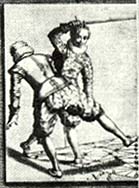 Seizures, disarms, close-in grabs, and left-hand parries have always
been tricky, always been risky, and always required practice in all types
of fencing. Perhaps there have always been fencers too conservative to
approve of them or to risk coming corps-a-corps ("body to body")
at all. But this doesn't mean that in the right circumstances they did
not work and cannot work again. These were (and are) advanced techniques
and even for advanced students may not always work perfectly (but then,
what techniques does?). If the circumstances are correct, and they fail,
it is the fighter not the technique which is at fault. Interestingly,
some schools and masters were still teaching grips and seizures up to
the 19th century. Against a lighter, shorter blade, these actions are
indeed harder to effect, but that only meant a swordsman would have to
be careful in the attempt -which was true with earlier weapons, as well.
Referring to French military duels with "skewers" (epees) of
the 1880’s, one author related "If it were not for the prospect
of that pointed rapier before them these soldiers might sometimes kick
and maul each other to death." Seizures, disarms, close-in grabs, and left-hand parries have always
been tricky, always been risky, and always required practice in all types
of fencing. Perhaps there have always been fencers too conservative to
approve of them or to risk coming corps-a-corps ("body to body")
at all. But this doesn't mean that in the right circumstances they did
not work and cannot work again. These were (and are) advanced techniques
and even for advanced students may not always work perfectly (but then,
what techniques does?). If the circumstances are correct, and they fail,
it is the fighter not the technique which is at fault. Interestingly,
some schools and masters were still teaching grips and seizures up to
the 19th century. Against a lighter, shorter blade, these actions are
indeed harder to effect, but that only meant a swordsman would have to
be careful in the attempt -which was true with earlier weapons, as well.
Referring to French military duels with "skewers" (epees) of
the 1880’s, one author related "If it were not for the prospect
of that pointed rapier before them these soldiers might sometimes kick
and maul each other to death."
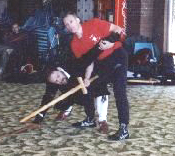 For some sword enthusiasts today, historical fencing means martial arts,
or techniques approached purely for self-defence, i.e., killing skills.
For others, fencing itself seems to mean only the art of the single sword
and only when conducted in a traditional pedagogy of mock dueling (a
combat selon les règles or a combat "according to the rules").
Yet, historians of dueling have pointed out that in the 1500s and 1600s,
little distinction was frequently made between brawls, sudden affrays,
rencounters, private assaults, and "duels" (either formal or
a' la mazza). This distinction even appears to have been the exception
rather than the rule. Some more traditional fencers may see as "brutal" any
earlier style that employs close-in actions, hand and foot blows, seizures,
grappling, and take-downs. This is understandable, as these much ignored
and long overlooked techniques are difficult to learn, dangerous to casually
practice, and highly awkward to safely use in free-play or bouting. They
may be considered "artless", "vulgar", or "base" to
attempt to use them "in place of proper fence". This is a real
shame. For these techniques have historical and martial validity and
they can be as fluid and graceful as any weapon and should they serve
to win a life-and death fight, to the winner they are neither improper
nor crude. In Martial Arts of Renaissance Europe, Dr. Anglo, astutely
comments on the styles of fighting in the Renaissance stating: "The
techniques involved – dealing with unequal odds, left hand parrying,
wrestling throws, ruthless battering about the head, stabbings, wards,
and a total commitment to death and destruction – are all much
the same as those described and illustrated by masters of arms from the
late fourteenth century onwards. And, however much such behavior may
later have been frowned upon by academic fencers, similar practices were
still being taught long after they are conventionally supposed to have
vanished from the sophisticated swordsman’s repertory. For some sword enthusiasts today, historical fencing means martial arts,
or techniques approached purely for self-defence, i.e., killing skills.
For others, fencing itself seems to mean only the art of the single sword
and only when conducted in a traditional pedagogy of mock dueling (a
combat selon les règles or a combat "according to the rules").
Yet, historians of dueling have pointed out that in the 1500s and 1600s,
little distinction was frequently made between brawls, sudden affrays,
rencounters, private assaults, and "duels" (either formal or
a' la mazza). This distinction even appears to have been the exception
rather than the rule. Some more traditional fencers may see as "brutal" any
earlier style that employs close-in actions, hand and foot blows, seizures,
grappling, and take-downs. This is understandable, as these much ignored
and long overlooked techniques are difficult to learn, dangerous to casually
practice, and highly awkward to safely use in free-play or bouting. They
may be considered "artless", "vulgar", or "base" to
attempt to use them "in place of proper fence". This is a real
shame. For these techniques have historical and martial validity and
they can be as fluid and graceful as any weapon and should they serve
to win a life-and death fight, to the winner they are neither improper
nor crude. In Martial Arts of Renaissance Europe, Dr. Anglo, astutely
comments on the styles of fighting in the Renaissance stating: "The
techniques involved – dealing with unequal odds, left hand parrying,
wrestling throws, ruthless battering about the head, stabbings, wards,
and a total commitment to death and destruction – are all much
the same as those described and illustrated by masters of arms from the
late fourteenth century onwards. And, however much such behavior may
later have been frowned upon by academic fencers, similar practices were
still being taught long after they are conventionally supposed to have
vanished from the sophisticated swordsman’s repertory.
 The view that rapiers were too quick to allow successful closing or
grappling is simply untrue. But, it’s understandable that as these
moves weren’t used, they weren’t taught any longer, and not
being taught they fell out of use. One fights the way one trains after
all. Wisely, one would not attempt these actions against an opponent
unless one had practiced them considerably in the first place, otherwise
they would certainly be foolish to attempt except in desperation (which
did occur). Surely it is unreasonable to believe that these things could
never have happened because an opponent would be hit before closing to
range is not borne out by the available evidence? Nor is it supported
by modern contests between "grappling" versus "non-grappling
fencers". Given the variety and length of rapier blades and Renaissance
swords that existed, and the greater and greater information now coming
to light on the various methods for using them, it would indeed be a
difficult proposition to justify. Thus, today’s historical fencing
practitioners should endeavor to experience the opportunity to go up
against someone skilled in them and use caution in declaring across the
board they do not work or would not be effective. The view that rapiers were too quick to allow successful closing or
grappling is simply untrue. But, it’s understandable that as these
moves weren’t used, they weren’t taught any longer, and not
being taught they fell out of use. One fights the way one trains after
all. Wisely, one would not attempt these actions against an opponent
unless one had practiced them considerably in the first place, otherwise
they would certainly be foolish to attempt except in desperation (which
did occur). Surely it is unreasonable to believe that these things could
never have happened because an opponent would be hit before closing to
range is not borne out by the available evidence? Nor is it supported
by modern contests between "grappling" versus "non-grappling
fencers". Given the variety and length of rapier blades and Renaissance
swords that existed, and the greater and greater information now coming
to light on the various methods for using them, it would indeed be a
difficult proposition to justify. Thus, today’s historical fencing
practitioners should endeavor to experience the opportunity to go up
against someone skilled in them and use caution in declaring across the
board they do not work or would not be effective.
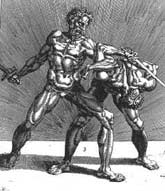 Were grappling and wrestling techniques always used in rapier fencing
then? No, of course not. But has their historical and martial importance
to rapier fencing been overlooked and under appreciated? Yes, from the
evidence presented it obviously seems so. If a fighter could kill or
defeat his adversary by skill with his blade alone, he surely would.
That is what wielding the armament is all about after all. But, if opportunity
presented itself and circumstances demanded it, he would utilize every
action in his repertoire. Knowledge of grappling and wrestling would
make it all the harder for such moves to be successfully used against
him. We might ponder if there is a gap or hole in a student’s rapier
skills if they are completely ignorant of these techniques, but who knows?
All we can do today is examine the accounts of duels and compare them
with the theoretical instructions in the manuals and our own limited
modern experiments. It can be hard to judge the value these moves contain
if modern rapier fencing enthusiasts today do not themselves regularly
practice them, may not even be aware of them, and neither have used them
successfully nor had them employed effectively against themselves. Were grappling and wrestling techniques always used in rapier fencing
then? No, of course not. But has their historical and martial importance
to rapier fencing been overlooked and under appreciated? Yes, from the
evidence presented it obviously seems so. If a fighter could kill or
defeat his adversary by skill with his blade alone, he surely would.
That is what wielding the armament is all about after all. But, if opportunity
presented itself and circumstances demanded it, he would utilize every
action in his repertoire. Knowledge of grappling and wrestling would
make it all the harder for such moves to be successfully used against
him. We might ponder if there is a gap or hole in a student’s rapier
skills if they are completely ignorant of these techniques, but who knows?
All we can do today is examine the accounts of duels and compare them
with the theoretical instructions in the manuals and our own limited
modern experiments. It can be hard to judge the value these moves contain
if modern rapier fencing enthusiasts today do not themselves regularly
practice them, may not even be aware of them, and neither have used them
successfully nor had them employed effectively against themselves.
Perhaps then, when it comes to fighting with historical hand-weapons,
the very view that there is such a thing as "close-quarter" combat
is itself artificial? Since virtually all "all-out" Medieval
and Renaissance combat involved, or at least anticipated and assumed,
close-in techniques of grappling and wrestling, there was no real necessity
to distinguish close-quarter from "non close-quarter". There
was only the need to identify classes of techniques that worked at one
range or another, and were employed either directly by weapon or by empty
hand and body. It would seem it was not until close-in actions were later
disavowed or discarded that a distinction apparently developed. It may
very well be that it was only the structured rules which limited the
application of grappling and wrestling, first within certain tournaments
and judicial duels and then the gentlemanly Code Duello, that armed combat
(and fencing in general) came to be characterized as something "other" than
close-combat (i.e., fighting at a range other than the weapon’s "reach").
 ARMA’s perspective is that of training and instructing. Hence,
our purpose is not academic theorizing but to interpret and practice
this subject as a martial art and to train in these skills --as close
as we can approximate to how they were historically intended to really
be used (in a traditional approach). Since its beginnings ARMA has emphasized
seizures, disarms, grappling, and close entering actions as crucial,
vital, and integral elements in all historical armed combat, including
rapier. These actions were real, they were historical, and they worked.
They were used by all manners of fighters from all classes of society
(indeed, they continued to later be described as highly useful by several
by 18th century small-sword masters). In our modern study now we must
not suppress them, ignore them, or make excuses for our ignorance of
them because they do not somehow fit a preconceived notion of how "proper" fencing
(whether Medieval or Renaissance) should have been conducted. Instead,
we must expose them, explore them, and try to master them. ARMA’s perspective is that of training and instructing. Hence,
our purpose is not academic theorizing but to interpret and practice
this subject as a martial art and to train in these skills --as close
as we can approximate to how they were historically intended to really
be used (in a traditional approach). Since its beginnings ARMA has emphasized
seizures, disarms, grappling, and close entering actions as crucial,
vital, and integral elements in all historical armed combat, including
rapier. These actions were real, they were historical, and they worked.
They were used by all manners of fighters from all classes of society
(indeed, they continued to later be described as highly useful by several
by 18th century small-sword masters). In our modern study now we must
not suppress them, ignore them, or make excuses for our ignorance of
them because they do not somehow fit a preconceived notion of how "proper" fencing
(whether Medieval or Renaissance) should have been conducted. Instead,
we must expose them, explore them, and try to master them.
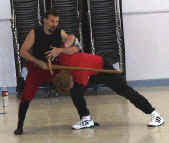 There is certainly far, far more that can be said about this subject,
and grappling and wrestling in Renaissance fencing alone could easily
be separated into two or more distinct areas of research. The skills
of entering in close to grab an opponent’s arm, hand or blade,
disarm them or trap them were used and are something that today’s
student of historical fencing should explore in detail. The techniques
of closing to take down or trip up and opponent can make all the difference
in a real sword fight and today are elements worthy of long-term investigation
by Renaissance fencing students. It has often been said that we should
not become prisoners to our style. Good ideas come from everywhere. There
are brilliant ideas in fighting and there are foolish ones. The job of
any earnest instructor is to honestly point them out. To quote the Master
Vadi from c. 1480, "You can also use in this Art strokes and close
techniques that you find simpler; leave the more complex, take those
favoring your side and often you will have honour in the Art." There is certainly far, far more that can be said about this subject,
and grappling and wrestling in Renaissance fencing alone could easily
be separated into two or more distinct areas of research. The skills
of entering in close to grab an opponent’s arm, hand or blade,
disarm them or trap them were used and are something that today’s
student of historical fencing should explore in detail. The techniques
of closing to take down or trip up and opponent can make all the difference
in a real sword fight and today are elements worthy of long-term investigation
by Renaissance fencing students. It has often been said that we should
not become prisoners to our style. Good ideas come from everywhere. There
are brilliant ideas in fighting and there are foolish ones. The job of
any earnest instructor is to honestly point them out. To quote the Master
Vadi from c. 1480, "You can also use in this Art strokes and close
techniques that you find simpler; leave the more complex, take those
favoring your side and often you will have honour in the Art."
About The Author:
John Clements is an authority on historical fencing and one of the world’s
foremost practitioners of Medieval and Renaissance fencing. He is a long-time
martial-artist who has been studying historical fencing since 1980. He
has practiced cut & thrust swordsmanship and rapier fighting for
more than eighteen years. John has researched swords and arms in 8 countries
and taught sword seminars in 6 countries. Since summer 1997 he has taught
public courses and private lessons in Houston. He has authored numerous
articles on swords and weapon fighting for several magazines including: Renaissance
Magazine, Tactical Knives, Karate International, Histoire'
Medievale, L’art de la Guerre, Master at Arms, The
Sword, Hammerterz Forum, Hop-Lite, and Sword Forum
International. John was also major contributor on historical fencing
as well as member of the editorial board to the new Martial Arts of the
World encyclopedia from ABC-CLIO Press (October 2001). He has also authored
five books including: Medieval Swordsmanship: Illustrated Methods & Techniques (Paladin
Press, Nov ’98) and Renaissance Swordsmanship: The Illustrated
Use of Rapiers and Cut-and-Thrust Swords (Paladin Press, March '97).
John has also been featured twice on The History Channel, and was the
creator and a founding member of the original Swordplay Symposium International.
In 1982 he founded the Medieval Battling Club. John is the Director of
The Association For Renaissance Martial
Arts (ARMA), where this article was originally featured.
|